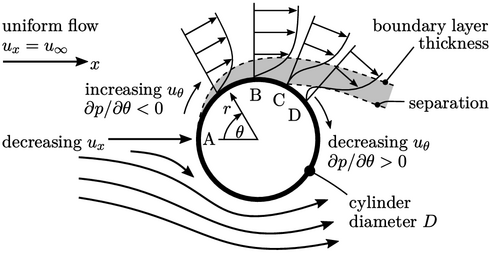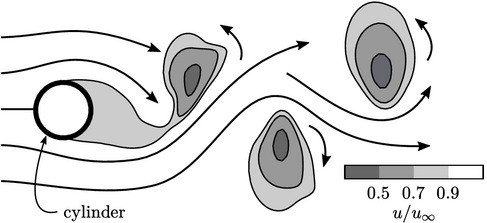6.5 Boundary layer separation
Boundary layers provide the main source of vorticity for turbulence as discussed in Sec. 6.4 . A boundary layer breaks away from the boundary when it reaches the end of the surface or by separation before reaching the end. Vorticity and turbulence are thereby swept into regions of fluid away from solid boundaries.
Flow around a cylinder illustrates boundary layer
separation, vorticity and turbulence. The fluid flows at uniform
velocity  upstream of the cylinder. It decelerates to stagnation,
upstream of the cylinder. It decelerates to stagnation,  , at point A on the
surface (in the
, at point A on the
surface (in the  -normal direction).
-normal direction).
High pressure at A introduces a favourable pressure gradient
 which
increases the flow speed
which
increases the flow speed  around the cylinder towards B, developing a
boundary layer in the process.
around the cylinder towards B, developing a
boundary layer in the process.

The flow reaches a peak speed at B, then
decelerates over the downstream side of the cylinder. The
adverse pressure gradient
 causes
causes
 to
decrease. At some point C, the velocity gradient can reach
to
decrease. At some point C, the velocity gradient can reach
 .
Beyond C, the boundary layer can separate such that
.
Beyond C, the boundary layer can separate such that  along its profile, see
point D.
along its profile, see
point D.
Boundary layer separation in a cylinder depends
on Reynolds number  , Eq. (2.68
), using
, Eq. (2.68
), using
 and
and  . For
. For  , there is no separation, with the flow exhibiting a
pattern downstream that mirrors the upstream flow.6
, there is no separation, with the flow exhibiting a
pattern downstream that mirrors the upstream flow.6
For  , the boundary layer separates with its
vorticity sustaining a pair of vortices attached to the rear of the
cylinder.
, the boundary layer separates with its
vorticity sustaining a pair of vortices attached to the rear of the
cylinder.

At  , vorticity is released downstream as vortices
break off from the cylinder in a periodic manner known as the
Kármán
vortex street, shown above.
, vorticity is released downstream as vortices
break off from the cylinder in a periodic manner known as the
Kármán
vortex street, shown above.
At  , the vorticity starts to become become chaotic,
with turbulence beginning to appear in the vortices. At
, the vorticity starts to become become chaotic,
with turbulence beginning to appear in the vortices. At
 ,
the entire wake region becomes turbulent.
,
the entire wake region becomes turbulent.
The frequency of vortex shedding is characterised
by another dimensionless number from Eq. (2.68
), the Strouhal
number  . For
. For  , experiments show7
, experiments show7  , where
, where  is the period at which the vortex pattern
repeats.
is the period at which the vortex pattern
repeats.

